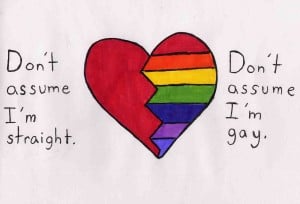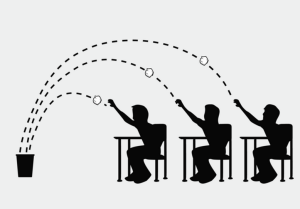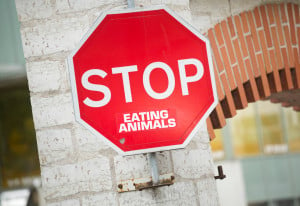
Source: Getty Images
Recently, I did a presentation on thinspiration (TW) for one of my graduate school classes. My entire group, actually, was focused on body image.
My two partners discussed body dysmorphia in the American MSM community and how globalization imperialism has affected beauty ideals in Southeast Asia. To round it out, I talked about online pro-eating disorder communities with a focus on the evils of thinspo.
Miraculously, since this never seems to happen during school-sanctioned presentations, we actually had time at the end for questions.
At which point, someone asked us about fitspo.
My friend Bruce* and I were quick to tear it down.
“Ughhh,” I complained. “Fitspiration is the worst. It’s just as bad as thinspo, but it’s cleverly disguised to look like it’s about health. But at the end of the day, it’s still promoting the idea that there’s only one body type that’s desirable.”
“Yeah,” Bruce chimed in. “I mean, how healthy is ‘strong is the new skinny?’” he asked, quoting fitspo’s mantra.
People nodded. They sighed. They shook their heads in dismay.
We sat down feeling like we had enlightened people.
Flash-forward to when it’s time to check out.
My graduate program is really touchy-feely, and so we tend to do check-ins and check-outs everyday, each person going around in a circle or popcorn-style to discuss their feelings.
And then someone in our class admitted that the conversation about fitspiration had sent her to the bathroom in tears, second-guessing all of the hard work that she had put into dieting and exercising for a happier, healthier her.
I traced embarrassed circles with my toe on the classroom carpeting.
And when I went home, I was quick to send her an e-mail, fumbling to explain that there are different kids of fitspo, and I was talking about one kind, and hopefully she had been using another kind, and ohmygod I never meant to belittle your self-love journey what can I do to help.
So I promised her that I’d write this article.
Because the truth is: There are different kinds of fitspiration. There are different approaches that all call themselves the same thing. And the mistake that I made in class that day was not distinguishing between them.
The Good
There are some health blogs that really are just that – health blogs. They’re actually about health and fitness.
The key here is that they focus on the benefits of a healthy lifestyle, not making a connection between health and body shape.
They post pictures of yummy, healthy meals, perfectly put together with pops of bright color and creative camera angles. They share creative recipes, helping you to figure out what to do with that quinoa that’s been sitting in your cabinet for months, showing that you can make do with anything.
They post pictures of happy, healthy people smiling, doing yoga, eating ripe, fresh fruit. They share inspirational quotes about body acceptance and tips for staying in a mentally-sound mindset.
Hell, even I follow some blogs like that (like this one and this one).
These blogs – which I like to think of as the good kind of fitspiration – are more about community and support, promoting healthy eating as a lifestyle choice.
In these blogs, health and fitness is about a decision to treat your body a certain way in the pursuit of health and happiness (not beauty) and to share that journey with others in a supportive, body-positive environment.
I’m all for it.
Unfortunately, this isn’t where fitspiration stops. It’s only where it begins.
The Bad
I’m a big fan of Shawn Johnson – a huge fan of Shawn Johnson, actually. Having grown up a competitive gymnast myself, I’m prone to following the careers of Olympic athletes even after they’ve retired.
And I follow Shawn. On Facebook, Twitter, and Instagram, I follow Shawn.
And I’m growing a little concerned.
Now that her gymnastics (and—uh—Dancing with the Stars) career is over, Shawn Johnson’s been picked up as a spokeswoman for Nike, gallivanting around the world, spreading the gospel of fitness.
Since then, though, her Instagram has been inundated with supposedly “inspirational” quotes which she tags – of course – #fitspiration. But these pictures look a lot more like aspiration than inspiration to me.
Just the other day, she posted a picture that says, “Your beach body starts now.”
And that’s a little worrisome. Because that’s not what fitness is supposed to be about.
And you know what? Okay. I could forgive it. There’s nothing wrong with being an athlete and therefore proud of your accomplishments. There’s nothing wrong with trying to inspire others to greatness.
But…
Most of your fans are gymnasts, Shawn!
They are at high risk for eating disorder behavior. They’re under constant pressure to be thin enough to succeed in a merciless (though beautiful and amazing, and I’d never say a bad thing about it) sport.
And when you consider that US gymnastics is less about fine lines and grace (like Eastern European gymnastics, for example) and more about strength and power (uhh—like Shawn Johnson), teaching young girls that “strong is the new skinny” doesn’t help them.
It doesn’t improve body image issues – it compounds them.
The Ugly
I don’t think that Shawn Johnson is sick, just like I don’t think that everyone who falls into the “Get Fit or GTFO” lifestyle has a problem.
I think that Shawn – and others like her – is doing the best that she can to spread awareness about something important to her – health and fitness – genuinely.
But I do think that she’s going about it in the wrong way. And I own that that’s my opinion, not a concrete fact.
But there’s a fine line between being someone who’s into fitness as a hobby or a lifestyle and being obsessive.
What concerns me is how many eating disorder “recovery” blogs that I visit on Tumblr that are just pages and pages of fitspiration. As if that’s somehow better.
As if it’s somehow healthier to work your ass off for one kind of a body over another.
“At least it’s not thinspo!” they argue.
The only difference is that now you’re looking for muscle instead of bone. But you’re still weighing, you’re still counting calories, you’re still standing in front of the mirror naked criticizing yourself.
You’re still telling yourself that tomorrow, you’ll do better.
And at the end of the day, body obsession is bad news.
Trying to force your body into what you deem to be an acceptable standard is by no means body-love. It’s body-hate.
Taking fitspiration to those kinds of extremes isn’t about health. It’s about aesthetics.
Need proof?
Where are the pictures of large, thick bodies on fitspiration blogs? Where are the wrestlers and the football players?
If your idea of “good enough” means fitting into a visual mold, you’re doing fitspo wrong.
But How Do I Know Which Kind of Fitspo Fan I Am?
Not sure if your indulgence in fitspiration is out of love or hate?
Here are three things to consider:
1. Fitspiration is supposed to inspire you to be fit. But: How do you define “fit?” How do you measure its success?
2. Fitspiration is supposed to leave you feeling inspired. But: After perusing fitspo, do you feel motivated and good about yourself? Or do you feel down on yourself and guilty or ashamed?
3. Fitspiration is supposed to be about health, not looks. So: Why do you use fitspo? What are you trying to inspire yourself to be? Are you trying to accomplish physical goals or aesthetic ones?
And then maybe you’ll have a better idea of why you’re a fan of fitspiration and whether or not that’s a good thing for your mind and body.
Because not all fitspo is bad.
But some of it actually inspires more unhealthy habits than healthy ones.
So be media literate and body-positive enough to know what you’re doing and why.
And choose your fitspo wisely.
Want to discuss this further? Login to our online forum and start a post! If you’re not already registered as a forum user, please register first here.
Melissa A. Fabello is the Editor at Everyday Feminism. She’s a feminist blogger and vlogger, as well as an online peer sex educator, based out of Philadelphia. Along with Everyday Feminism, Melissa also currently works with Miss Representation, Adios Barbie, and Laci Green’s Sex+ community. She is a second-year graduate student, working on an M.Ed. in Human Sexuality. She can be reached on Twitter @fyeahmfabello. Read her articles here and book her for speaking engagements here.
Search our 3000+ articles!
Read our articles about:
Our online racial justice training
Used by hundreds of universities, non-profits, and businesses.
Click to learn more




















